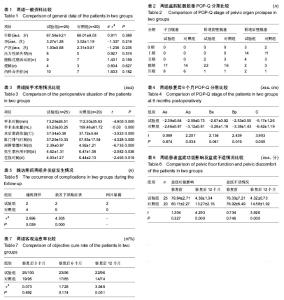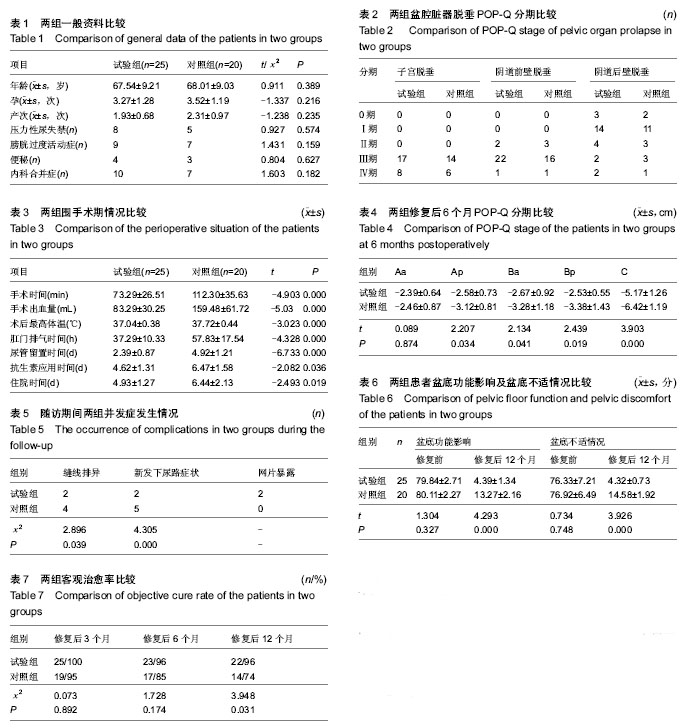| [1] Giarenis I,Robinson D. Prevention and management of pelvic organ prolapse. F1000Prime Rep.2014;6:77.
[2] Maher C,Feiner B,Baessler K,et al.Surgical management of pelvic organ prolapse in women.Cochrane Database Syst Rev.2013;4:CD004014.
[3] 肖建萍,姚丽艳.Prolift生物网片材料盆底重建与传统手术治疗盆底功能障碍的Meta分析[J].中国组织工程研究,2014,18(43): 7039-7046.
[4] 马辛欣,孙秀丽,杨欣,等.应用化学合成非吸收补片盆底重建手术患者生活质量调查分析[J].实用妇产科杂志,2014,30(12): 933-936.
[5] 杨翔,童晓文,李怀芳.生物源性材料在女性盆底重建中的作用[J].中国组织工程研究与临床康复,2011,15(29):5475-5478.
[6] 何萍,刘禄斌,邓凯贤,等.两种补片在前盆底重建术中的应用比较[J].实用妇产科杂志, 2014,30(5):385-388.
[7] 宋利.补片在妇产科疾病中的临床应用及其生物相容性[J].中国组织工程研究, 2012,16(12):2253-2256.
[8] 吴东辉.不同盆底补片在盆底重建术患者中的应用效果与安全性比较[J].中国现代医学杂志,2014,24(21):60-63.
[9] 盛慧娟.聚丙烯网片应用于女性盆底功能障碍手术疗效探讨[D].南京:南京中医药大学,2013.
[10] 徐玲玲,沈宇飞.应用生物补片治疗盆腔脏器脱垂23例临床分析[J].现代妇产科进展, 2014,3(6):476-477.
[11] 马辛欣,孙秀丽,杨欣,等.Prolift和Avaulta补片前盆腔重建手术疗效分析[J].中国妇产科临床杂志,2014,23(6):476-477.
[12] 张卓梅,赵春艳,同军,等.Prolift全盆底重建术治疗老年女性盆腔器官脱垂89例临床分析[J].中华实用诊断与治疗杂志,2012, 26(9):932-933.
[13] Thomin A,Touboul C,Hequet D,et al.Genital prolapse repair with Avaulta Plus mesh: functional results and quality of life. Prog Urol.2013;23(4):270-275.
[14] 蒋琼.盆底重建术治疗女性盆腔器官脱垂的临床分析[D].广西:广西医科大学,2014.
[15] 苏璿.阴式全子宫切除术加阴道前后壁修补术治疗子宫脱垂的临床疗效观察[J].海南医学,2012,23(24):43-45.
[16] 张迎辉,鲁永鲜,王文英,等.阴道封闭术对盆腔器官脱垂患者排尿困扰症状的疗效观察[J].军医进修学院学报,2011,32(7): 701-703.
[17] Barber MD,Maher C.Epidemiology and outcome assessment of pelvic organ prolapse.Int Urogynecol J.2013;24(11): 1783-1790.
[18] 黄志宏,左约维,罗怀钦.经阴道骶棘韧带悬吊术治疗盆腔器官脱垂的疗效观察[J].中国全科医学,2012,15(21):2464-2465.
[19] 峰,陈丽娟,王艳艳,等.女性盆腔脏器脱垂的治疗进展[J].中国妇幼保健, 2014,29(25):4188-4190.
[20] 王玉玲,岳宜琦.盆底功能障碍性疾病的手术方式的研究进展[J].中华临床医师杂志(电子版),2012,6(24):8276-8278.
[21] 张丽英.不同术式治疗重度盆腔脏器脱垂的临床对比研究[J].医学综述, 2014,20(12):2275-2277.
[22] 王芳. 生物补片材料在盆底功能重建中的应用[J].中国组织工程研究, 2012,16(25):4719-4726.
[23] von Theohald P. Place of mesh in vaginal surgery, including its removal and revision.Best Pract Res Clin Obstet Gynaecol. 2011;25(2):197-203. |

